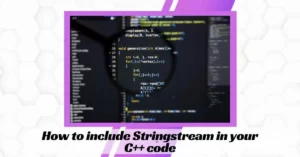Table of Contents
ToggleIntroduction
Stringstream is a class in C++ that allows you to manipulate strings as if they were input or output streams. Stringstream in C++ provides a convenient and powerful way to convert data between strings and other data types, split a string into substrings, and manipulate strings in a variety of other ways.
The Stringstream class is part of the standard C++ library, which means that it’s available in all modern C++ compilers. It’s easy to include in your C++ code by including the <sstream> header file.
Using string stream is fairly straightforward. You create an instance of the string stream class and then use it to read or write data to and from a string. You can also use string stream to format data into a string in a specific format.
One of the primary advantages of using Stringstream is its flexibility. You can use it to manipulate strings in a variety of ways, without having to worry about the details of parsing and formatting strings manually. This makes it a powerful tool for a wide range of C++ programming tasks.
In summary, Stringstream is a powerful and flexible tool for manipulating strings in C++. Whether you’re working with simple data types or more complex data structures, Stringstream can help you easily convert, parse, and format strings as needed.
How to include stringstream in your C++ code?

To use Stringstream in your C++ code, you need to include the <sstream> header file in your program. This header file contains the definition of the Stringstream class, as well as other related classes and functions.
To include the <sstream> header file, you simply add the following line at the top of your C++ code:
c++
Copy code
#include <sstream>
Once you’ve included the <sstream> header file, you can create an instance of the Stringstream class and use it to read or write data to and from a string. For example, you can use the stringstream class to convert an integer to a string as follows:
C++
#include <iostream>
#include <sstream>
int main() {
int num = 42;
std::stringstream ss;
ss << num;
std::string str = ss.str();
std::cout << “The string representation of ” << num << ” is: ” << str << std::endl;
return 0;
}
In this example, we create an instance of the Stringstream in C+ class called ‘ss’, and use the ‘<<‘ operator to insert the integer value ‘num’ into the stringstream in C+ object. We then use the ‘str()’ method to get the string representation of the Stringstream in C+ object, and store it in a string variable called ‘str’. Finally, we print out the string representation of the integer ‘num’ to the console.
In summary, including Stringstream in C++ in your C++ code is as simple as adding the <sstream> header file to your program. From there, you can create an instance of the Stringstream in C++ class and use it to manipulate strings as needed.
Click here to know more about: data science colleges in Pune
Understanding the anatomy of a stringstream in C++ object

A Stringstream object in C++ is an instance of the stringstream class, which allows you to manipulate strings as if they were input or output streams. In order to understand the anatomy of a Stringstream object, it’s helpful to look at the various components that make it up.
Firstly, a Stringstream object has a state, which can be either good or bad. This state is determined by the most recent operation performed on the object, and can be checked using the ‘good()’, ‘eof()’, ‘fail()’, and ‘bad()’ member functions of the stringstream class.
Secondly, a Stringstream in C++ object has a buffer, which is used to store the characters that make up the string being manipulated. This buffer can be either an input buffer or an output buffer, depending on whether the Stringstream in C+ is being used to read from or write to a string.
Thirdly, a Stringstream in C+ object has a number of member functions that can be used to manipulate the contents of the buffer. These include ‘operator<<‘ and ‘operator>>’, which are used to insert and extract data from the buffer, as well as ‘str()’, which is used to get the contents of the buffer as a string.
Finally, a Stringstream in C++ object can be used to perform a variety of other operations on the string being manipulated, such as converting data between different types, splitting the string into substrings, and formatting the string in a particular way.
In summary, a Stringstream in C++ object in C++ is a powerful tool for manipulating strings as if they were input or output streams. Understanding the anatomy of a Stringstream in C++ object is important for effectively using its various features and functions to manipulate strings in your C++ code.
Converting Strings to other Data Types using Stringstream in C++
One of the key features of Stringstream in C+ is its ability to convert strings to other data types. This is done using the extraction operator ‘>>’, which is overloaded in the stringstream class to extract data from the Stringstream in C++ buffer and convert it to a specific data type.
To convert a string to another data type using Stringstream, you first create an instance of the stringstream class and insert the string into the stringstream buffer using the insertion operator ‘<<‘. You can then use the extraction operator ‘>>’ to extract the data from the buffer and convert it to the desired data type.
For example, to convert a string containing a number to an integer, you could do the following:
C++
#include <iostream>
#include <string>
#include <sstream>
int main() {
std::string str_num = “42”;
std::stringstream ss(str_num);
int num;
ss >> num;
std::cout << “The integer representation of the string ” << str_num << ” is: ” << num << std::endl;
return 0;
}
In this example, we create an instance of the Stringstream in C++ class called ‘ss’ and insert the string “42” into its buffer. We then use the extraction operator ‘>>’ to extract the integer value from the buffer and store it in the variable ‘num’. Finally, we print out the integer value of the string “42” to the console.
Stringstream in C++ can be used to convert strings to a wide range of data types, including integers, floats, doubles, and more. By using the insertion and extraction operators, you can easily convert strings to the desired data type and perform further operations on the converted data as needed.
In summary, Stringstream in C+ provides a powerful and flexible way to convert strings to other data types. By using the insertion and extraction operators, you can easily convert strings to integers, floats, doubles, and other data types as needed.
Also read abou
t: data science course fees in Mumbai
Using stringstream to split a string into substrings

Stringstream in C++ can be used to split a string into substrings, based on a delimiter character or string. This can be useful in a variety of situations, such as parsing data from a file or processing user input.
To split a string into substrings using Stringstream, you first create an instance of the stringstream class and insert the original string into its buffer. You can then use the getline function of the stringstream class to read a single line of text from the buffer, up to a specified delimiter character or string. The getline function returns a string containing the extracted text, which can be stored in a vector or other data structure for further processing.
For example, to split a comma-separated string into individual substrings, you could do the following:
C++
#include <iostream>
#include <string>
#include <sstream>
#include <vector>
int main() {
std::string str = “apple,banana,orange”;
std::stringstream ss(str);
std::vector<std::string> substrings;
std::string substring;
while (getline(ss, substring, ‘,’)) {
substrings.push_back(substring);
}
for (auto sub : substrings) {
std::cout << sub << std::endl;
}
return 0;
}
In this example, we create an instance of the stringstream class called ‘ss’ and insert the string “apple,banana,orange” into its buffer. We then use a while loop to read individual substrings from the buffer using the getline function, up to the delimiter character ‘,’ (a comma in this case). Each substring is stored in a vector called ‘substrings’. Finally, we print out each substring in the vector to the console.
Stringstream can be used to split strings into substrings based on any delimiter character or string, making it a powerful tool for processing text data in C++. By using the getline function and storing the extracted substrings in a vector or other data structure, you can easily manipulate and process the data in your code.
Stringstream Error Handling and Exceptions
Stringstream in C++ provides error handling and exception mechanisms to handle errors that may occur during input and output operations. There are two types of errors that can occur with Stringstream: formatting errors and runtime errors.
Formatting errors occur when the input string cannot be formatted according to the expected data type. For example, if you try to extract an integer from a string that contains non-numeric characters, a formatting error will occur. To handle formatting errors, you can use the ‘fail’ function of the stringstream class, which returns true if a formatting error has occurred. You can also use the ‘clear’ function to clear any error flags that may have been set.
Runtime errors occur when an error occurs during input or output operations that are not related to formatting. For example, if the input stream reaches the end of the file unexpectedly, a runtime error will occur. To handle runtime errors, you can use try-catch blocks to catch any exceptions that may be thrown. Stringstream provides several exception classes, including ios_base::failure and std::runtime_error, which can be caught and handled as needed.
For example, to handle both formatting and runtime errors when extracting an integer from a string using Stringstream, you could do the following:
C++
#include <iostream>
#include <string>
#include <sstream>
#include <stdexcept>
int main() {
std::string str_num = “42abc”;
std::stringstream ss(str_num);
int num;
try {
ss >> num;
if (ss.fail()) {
throw std::runtime_error(“Formatting error”);
}
std::cout << “The integer representation of the string ” << str_num << ” is: ” << num << std::endl;
} catch (std::exception& e) {
std::cerr << “Error: ” << e.what() << std::endl;
}
return 0;
}
In this example, we create an instance of the stringstream class called ‘ss’ and insert the string “42abc” into its buffer. We then use a try-catch block to catch any exceptions that may be thrown during the extraction operation. If a formatting error occurs, we throw a std::runtime_error exception with the message “Formatting error”. If no errors occur, we print out the integer value of the string “42abc” to the console.
Stringstream’s error handling and exception mechanisms provide a flexible and powerful way to handle errors that may occur during input and output operations. By using the fail and clear functions to handle formatting errors and try-catch blocks to handle runtime errors, you can ensure that your code handles errors gracefully and provides meaningful error messages to users.
Stringstream vs Traditional C++ Input/Output Methods
Stringstream and traditional C++ input/output methods serve different purposes and have their own advantages and disadvantages.
Traditional C++ input/output methods, such as cin and cout, are used for console-based input/output operations. They are easy to use and provide a simple way to interact with users through the console. However, they can be limited in their capabilities, especially when it comes to formatting input and output.
On the other hand, Stringstream is a powerful tool for processing text data in C++. It allows for more flexible input and output operations, including the ability to convert strings to other data types and split strings into substrings. It also provides error handling and exception mechanisms to handle errors that may occur during input and output operations.
Stringstream can be particularly useful when working with text files or when processing large amounts of text data. It provides a way to easily manipulate and process text data in memory, without the need for external files or complex parsing algorithms. However, it may not be as intuitive to use as traditional input/output methods, especially for beginners.
Overall, the choice between Stringstream in C++ and traditional C++ input/output methods depends on the specific requirements of your program. If you need to process text data in memory, Stringstream in C++ may be the better option. If you need to interact with users through the console, traditional input/output methods may be more appropriate.
Best practices for using Stringstream in your code
Here are some best practices for using Stringstream in your C++ code:
Always include the necessary header files: To use Stringstream , you need to include the <sstream> header file. Additionally, you may need to include other header files depending on your specific use case.
Avoid using Stringstream in C++ unnecessarily: While Stringstream can be a powerful tool, it should not be used unnecessarily. For simple input/output operations, traditional C++ input/output methods such as cin and cout may be more appropriate.
Clear the Stringstream object before reuse: Before reusing a Stringstream object, make sure to clear its state using the ‘clear’ function. This will reset any error flags that may have been set during previous operations.
Use exception handling to handle errors: Stringstream provides exception classes, including ios_base::failure and std::runtime_error, to handle errors that may occur during input a
nd output operations. Use try-catch blocks to catch any exceptions that may be thrown and handle them appropriately.
Use std: stringstream instead of std::ostringstream or std::istringstream: Unless you specifically need to write to or read from a stream, use std::stringstream for maximum flexibility.
Avoid chaining multiple operations on a single line: Chaining multiple operations on a single line can make your code harder to read and debug. Instead, use multiple lines to separate operations and make your code more readable.
Use the appropriate data type when extracting from a Stringstream object: When extracting data from a Stringstream object, make sure to use the appropriate data type for the data being extracted. This will help avoid formatting errors and ensure that the extracted data is of the correct type.
By following these best practices, you can ensure that your code using Stringstream is efficient, error-free, and easy to maintain.
Examples of Real-World use Cases for Stringstream
Stringstream is a versatile tool that can be used in many real-world scenarios. Here are a few examples:
Data validation: Stringstream can be used to validate data input by users. For example, you can use Stringstream in C+ to check whether a user has entered a valid phone number or email address.
Parsing and tokenizing: Stringstream in C++ can be used to parse and tokenize data from various sources, including text files and web pages. For example, you can use Stringstream in C++ to extract specific data fields from a CSV file.
Data serialization and deserialization: Stringstream in C++ can be used to serialize data into a text format and deserialize it back into its original data type. This can be useful when transmitting data over a network or storing data in a file.
String manipulation: Stringstream in C++ can be used to perform various string manipulations, such as converting strings to uppercase or lowercase, trimming whitespace, and replacing substrings.
Date and time manipulation: Stringstream in C++ can be used to convert date and time strings into various formats and perform calculations with them. For example, you can use Stringstream in C++ to calculate the difference between two dates or times.
Scientific computing: Stringstream in C++ can be used to read and write data from scientific computing tools such as MATLAB and Python. This can be useful when transferring data between different computing platforms.
Overall, stringstream in C++ is a powerful tool that can be used in a wide range of applications. Its flexibility and error-handling capabilities make it an essential tool for many developers.
Conclusion
In conclusion, Stringstream in C++ is a versatile tool for input/output operations that allows for flexible string manipulation and conversion of data types. It provides an efficient and error-handling mechanism for reading and writing data from and to string streams. The Stringstream object acts as an intermediary between the program and the input/output device, providing a buffer for the data stream.
Stringstream can be used in a variety of real-world applications, such as data validation, parsing and tokenizing, serialization and deserialization, string manipulation, and date and time manipulation. It is an important tool for scientific computing and can be used to read and write data from different computing platforms.
To use Stringstream effectively, it is essential to follow best practices such as including necessary header files, avoiding unnecessary use of stringstream, clearing the stringstream object before reuse, using exception handling to handle errors, and using the appropriate data type when extracting data from the stringstream object.
Overall, Stringstream in C++ provides a flexible and efficient way of manipulating string data, and it is an essential tool for many developers.
Frequently Asked Questions
What is Stringstream in C++?
Stringstream is a class in C++ that allows for flexible input and output operations with strings. It provides a stream buffer for string data that can be used to extract or insert data of various data types.
How do I include Stringstream in C++ code?
You can include Stringstream in your C++ code by including the <sstream> header file in your code. This header file defines the Stringstream class and its associated functions.
Can I use Stringstream to convert a string to an integer in C++?
Yes, you can use Stringstream to convert a string to an integer in C++. To do this, you can use the std::stoi function, which takes a string as an argument and returns an integer.
How do I handle errors when using Stringstream in C++?
You can handle errors when using Stringstream in C++ by using exception handling. If an error occurs during input/output operations, a std::ios_base::failure exception will be thrown, which you can catch and handle appropriately.
What are some best practices for using Stringstream in C++?
Some best practices for using Stringstream in C++ include clearing the Stringstream object before reuse, using the appropriate data type when extracting data from the Stringstream object, avoiding unnecessary use of Stringstream, and using exception handling to handle errors.













